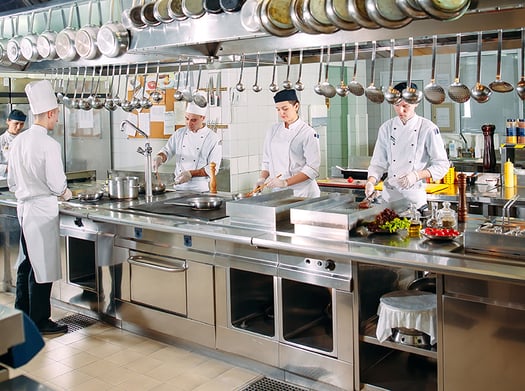A few years back, researchers conducted a study to determine which floor areas of a commercial kitchen were the least and the most slippery. As you can imagine, for chefs and kitchen workers, this is crucial information to know. When slip-and-fall accidents happen in a restaurant or a food service location, they are far more likely to occur in the back of the house—in the kitchen—than in the dining areas.
 The researchers also compared two different types of areas in a commercial kitchen:
The researchers also compared two different types of areas in a commercial kitchen:
Dry kitchen. A dry kitchen is typically where drier food preparation tasks are performed. This could include preparing dough for pizzas, cutting cooked meats and chicken to serve as snacks or appetizers, cutting bakery items, and so forth.
Wet kitchen. A wet kitchen refers to areas where, for instance, meat, chicken, fish, or vegetables are cleaned, cut, and prepared, often requiring considerable amounts of water and oils. In many cases, these are the areas where liquids drip from counters onto the surrounding floor.
The study, which included a total of 303 food service employees, was conducted in 57 elementary, high school, and business food service operations for one week. During that time, nearly 1,000 meals were cooked in the wet and dry kitchen areas.
- Of those working in dry kitchens, 40 % reported that the floor was slippery at one or more times during the week.
- 92 % of those working in wet kitchens said that the floor was slippery during the week.
- 61.5 % of the dry kitchen workers reported that slip-related accidents occurred once or twice per year in dry kitchens.
- 67 % of the workers in wet kitchens reported some type of slip or floor-related "incident" or accident at least once per month.
- 30 % of the staff in the dry kitchens reported never experiencing a work-related accident as a result of a slippery kitchen floor.
- Only 25 % of those in the wet kitchens reported never experiencing a work-related accident due to a slippery floor.
The findings are not that surprising. We would expect the floors in a wet kitchen to be slipperier than in a dry kitchen. We would also assume this to be where most of the floor-related incidents and accidents occur. Now the issue is what we can do about this situation?
One of the best options is to install floor mats designed for use in a commercial kitchen that allow drainage. This means oils, grease, and moisture—which cause most of the slips and falls in a commercial kitchen—drain under the mat and onto the floor below. Safe-Flow Plus is a mat designed for use in heavy-duty work situations and would provide increased safety because of the molded ramps.
Also, be sure to look for mats with anti-fatigue properties. There is rarely any sitting down in a busy commercial kitchen. In this instance, a good anti-fatigue mat such as Safewalk would help prevent aches and pains from extended standing.
For more information on restaurant kitchen mats, contact a Crown Matting Technologies Specialist.
Source: Chang HJ, Kim JW, Ju SY, Go ES. How do the work environment and work safety differ between the dry and wet kitchen foodservice facilities? Nutrition Research and Practice. June 4, 2012: 366–374.
Comments